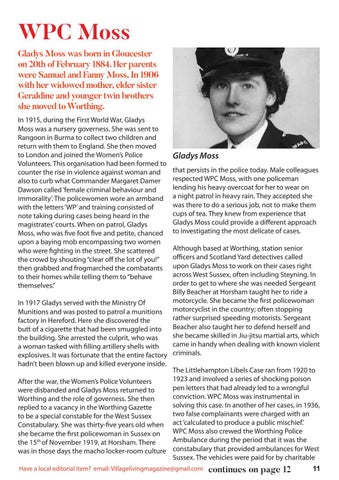WPC Moss Gladys Moss was born in Gloucester on 20th of February 1884. Her parents were Samuel and Fanny Moss. In 1906 with her widowed mother, elder sister Geraldine and younger twin brothers she moved to Worthing. In 1915, during the First World War, Gladys Moss was a nursery governess. She was sent to Rangoon in Burma to collect two children and return with them to England. She then moved to London and joined the Women’s Police Volunteers. This organisation had been formed to counter the rise in violence against woman and also to curb what Commander Margaret Damer Dawson called ‘female criminal behaviour and immorality’. The policewomen wore an armband with the letters ‘WP’ and training consisted of note taking during cases being heard in the magistrates’ courts. When on patrol, Gladys Moss, who was five foot five and petite, chanced upon a baying mob encompassing two women who were fighting in the street. She scattered the crowd by shouting “clear off the lot of you!” then grabbed and frogmarched the combatants to their homes while telling them to “behave themselves.”
Gladys Moss that persists in the police today. Male colleagues respected WPC Moss, with one policeman lending his heavy overcoat for her to wear on a night patrol in heavy rain. They accepted she was there to do a serious job, not to make them cups of tea. They knew from experience that Gladys Moss could provide a different approach to investigating the most delicate of cases.
Although based at Worthing, station senior officers and Scotland Yard detectives called upon Gladys Moss to work on their cases right across West Sussex, often including Steyning. In order to get to where she was needed Sergeant Billy Beacher at Horsham taught her to ride a motorcycle. She became the first policewoman In 1917 Gladys served with the Ministry Of Munitions and was posted to patrol a munitions motorcyclist in the country; often stopping rather surprised speeding motorists. Sergeant factory in Hereford. Here she discovered the Beacher also taught her to defend herself and butt of a cigarette that had been smuggled into she became skilled in Jiu-jitsu martial arts, which the building. She arrested the culprit, who was came in handy when dealing with known violent a woman tasked with filling artillery shells with explosives. It was fortunate that the entire factory criminals. hadn’t been blown up and killed everyone inside. The Littlehampton Libels Case ran from 1920 to 1923 and involved a series of shocking poison After the war, the Women’s Police Volunteers pen letters that had already led to a wrongful were disbanded and Gladys Moss returned to conviction. WPC Moss was instrumental in Worthing and the role of governess. She then solving this case. In another of her cases, in 1936, replied to a vacancy in the Worthing Gazette two false complainants were charged with an to be a special constable for the West Sussex Constabulary. She was thirty-five years old when act ‘calculated to produce a public mischief.’ WPC Moss also crewed the Worthing Police she became the first policewoman in Sussex on Ambulance during the period that it was the the 15th of November 1919, at Horsham. There was in those days the macho locker-room culture constabulary that provided ambulances for West Sussex. The vehicles were paid for by charitable Have a local editorial item? email: Villagelivingmagazine@gmail.com
continues on page 12
11



